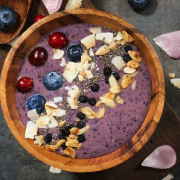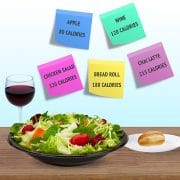Let’s Focus on Fructose
 Fructose – or ‘fruit sugar’ is found not only in fruit but also in small amounts in some vegetables, table sugar and honey. Fructose is a hot topic in the media and with good reason. We’re eating way too much of it and our bodies are not designed to cope with these large quantities. However, there are a lot of fad diets and opinions on how to manage our fructose consumption, which can be confusing. We’re here to give you sound information on this highly talked about sugar
Fructose – or ‘fruit sugar’ is found not only in fruit but also in small amounts in some vegetables, table sugar and honey. Fructose is a hot topic in the media and with good reason. We’re eating way too much of it and our bodies are not designed to cope with these large quantities. However, there are a lot of fad diets and opinions on how to manage our fructose consumption, which can be confusing. We’re here to give you sound information on this highly talked about sugar
The only fructose in the diet of our caveman ancestors was in the limited supply of honey, berries and other seasonal fruits. Today, the majority of our fructose consumption doesn’t come from fruit. It comes from the processed, convenience foods we have at our fingertips. Things like breakfast cereals, yogurt, soft-drinks, sports drinks, cakes, sweets, biscuits, store-bought pasta sauce and tomato sauce (and that’s just scratching the surface). It’s hard to avoid!
The association between sugar, obesity and disease is supported by the high intakes of sugar which health surveys are indicating. Whether fructose is the cause of this or just one of the factors of lifestyle choice, is debatable. However, it’s certainly not helping and that is something that can’t be argued.
So, what’s the issue with fructose?
To start with, a small amount of fructose is metabolised in the liver and is eventually stored as liver glycogen for energy, which is great if you’re very active. The problem is, most of us aren’t having a small amount so the liver ends up converting it to fat.
Not only do high levels of fructose lead to the synthesis of fat, they also fail to stimulate the hormone Leptin, which is responsible for sending messages to the brain that we’ve eaten enough and feel full. This means eating a high fructose diet can lead to overeating because, despite the amount we’re consuming, we don’t feel full and will end up overeating.
What about whole fruit?
With the media focus on fructose, many fad diets and so-called ‘experts’ have demonised fruit due to the fructose they contain. It’s important not to mistake low levels of fructose as the problem as it’s high levels that the liver can’t handle. Unless your body has problems absorbing fructose, eating 1-2 whole, fresh fruit each day is an important source of fibre, vitamins and minerals the body needs.
Does that include fruit juice?
So many of us grew up starting the day with a glass of orange juice and many are now offering the same to their kids under the guise of it being healthy. A glass of juice may offer vitamins, but through processing the fruit to juice, the majority of fibre is extracted and what you are left with is a glass of fructose. With its high levels of fructose, fruit juice is a treat food. Smoothies use the whole fruit, so are a better source of fruit than juicing. Many people now process the whole fruit with a bit of water to enjoy a glass of juice.
Which foods contain the highest and lowest amounts of fructose?
A good source of guidance on the foods that are highest and lowest in fructose can be found at this site: www.food-intolerance-network.com. As this site points out, however, some foods that are high in fructose can generally be tolerated better than others, partly due to the amount of glucose and other nutrients it is combined with.



